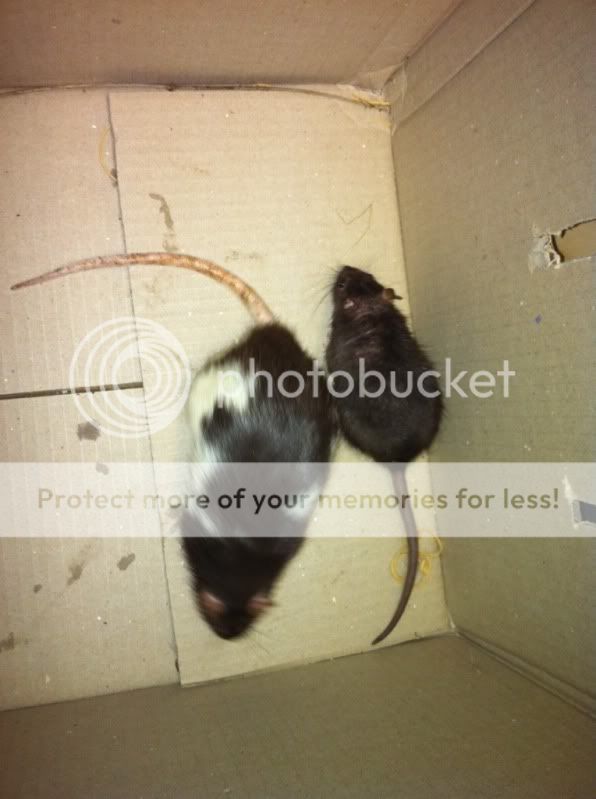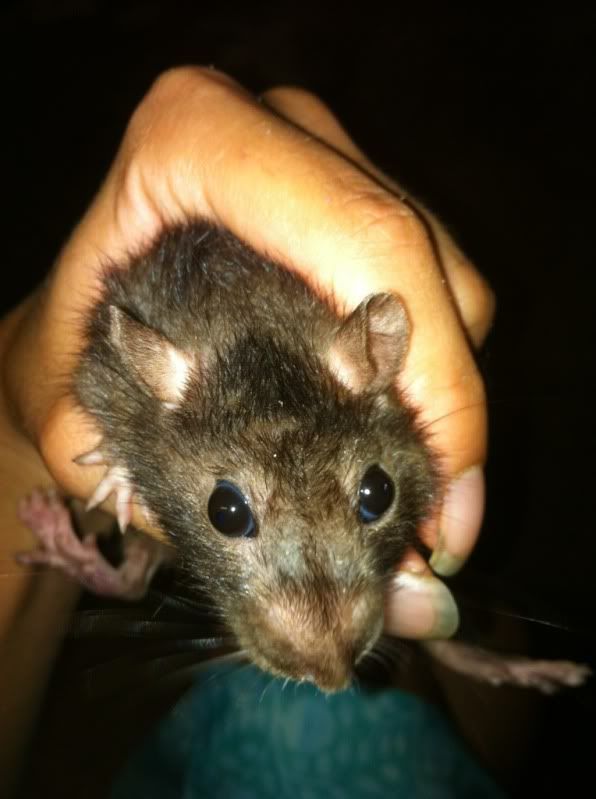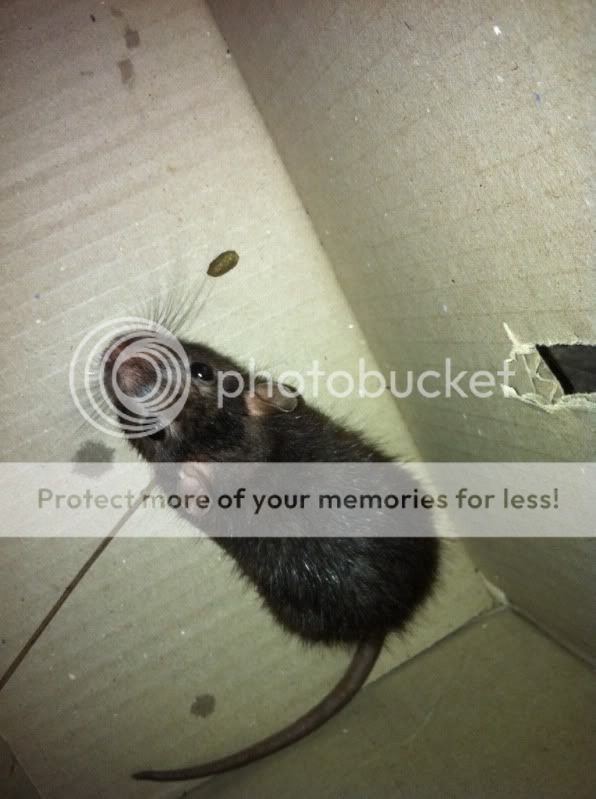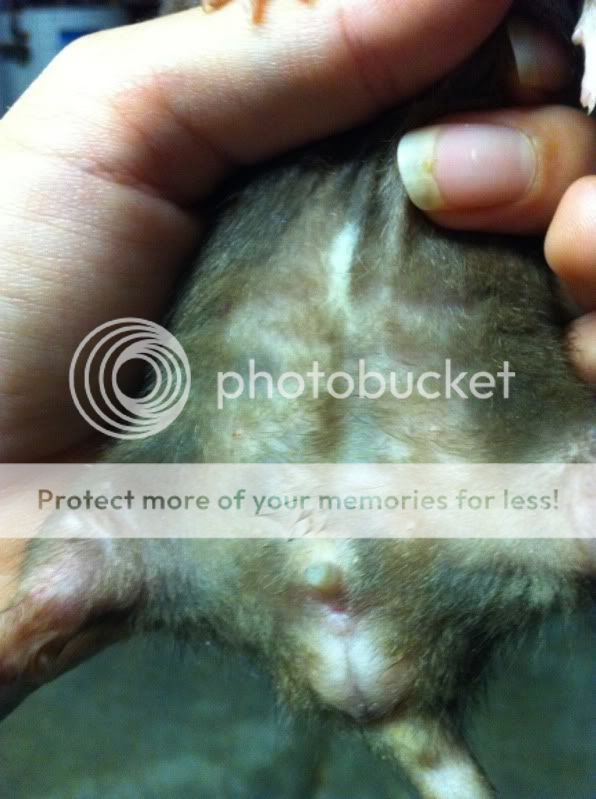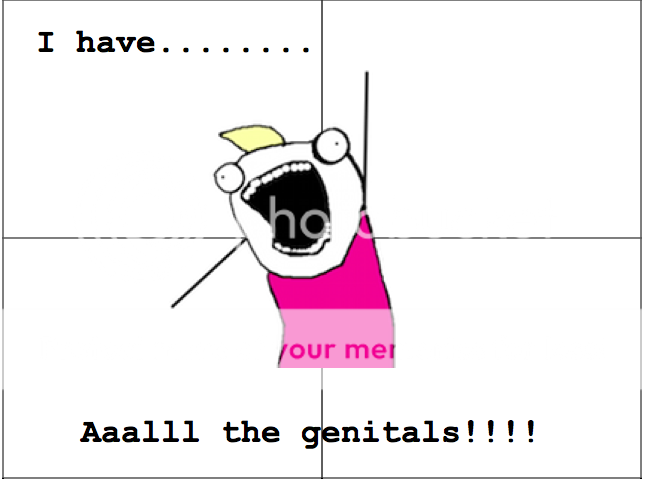There is no need to feel sorry for this little He-Girl. He (I just call it he because he lives with the spare boys) is happy and healthy. He has no less quality of life than the others

Maybe Heshe's eyes are poking out because you're squeezing too tight!!?? lol
On a serious note, do you find that the brown/"wild rat" colourations are more susceptible to myco? I only ask because my daughters picked a brown rat from a litter as a pet. It has been upstairs in a more airy environment than my snake food colony, with only one friend. The friend is a ginger and is well, the brown is wheezy. The ginger is male and the brown female, it isn't just porphyrin (it is also clear).
Lol awh I'm not squeezing him. While some mutations are known to cause health problems (rex varieties), differences in health depending on colour are not so obvious *if you select for health equally amongst the colours you keep. In other words - the health of the rats you breed, to some extent, is in your hands. That being said, it takes years of selective inbreeding to weed out genetic floors relating to health and slowly raise the overall quality of a group of breeding rats. Rat health and lifespan these days is not what it used to be. The rise of new colour, pattern and coat mutations have tempted a lot of people to breed genetically weaker rats that pass on their weakness to babies. Also some people who breed for snake food don't really 'select' for anything despite culling problem animals. If you cull a mother rat for biting you, then you cull all it's babies too. Same goes for health. If you want to improve anything, you need to cull all the babies of a rat that gets sick and skinny ahead of any other same aged breeders you have. This includes rats that still look healthy but make an audible 'rattling' noise from their chest.
Sooo Jham66 No matter what the colour of a rat is that you select to bring inside as a pet, it would have had a similar chance of being sick as any of the other colours you are breeding. Unless you are the one selecting for looks over health for certain colours that you keep, and health over looks for others.
Lab rats are interesting to work with too. They are known for their great mothering abilities and non agressive nature. However, they also tend to be much less fit than other rats I have bred, and burn out quickly. A line is not considered a line in the lab scenario, unless it has been inbred so many times that you are up to generations 16-20 or more. This means lab guys are able to really select for good mothering ability and anything else favourable for the rat's purpose. They have been selected to thrive in a sterile lab environment so when you take them out of the lab, they remain fantastic mothers but have no genetic resistance to the conditions that we keep them in. Their weakness is not due to their albinism. Fortunately they are the easiest type of rat to improve on because they all look identical so you have nothing to select for but health and performance.
The best way to improve the health of your breeding stock is to look at a litter when it reaches about 8 weeks of age (If they haven't been culled already for food) and choose the biggest and healthiest of the litter, and breed them together. Then do the same from their litters. Rats don't suffer from inbreeding depression like other species do, and all you are doing is exposing and weeding out any traits that would cause sickness. Each new generation is a small progression. Also cull any biting mums or agressive males along the way, and any mums that produce too large or too small litters or sickly babies, (as well as culling their offspring) and BAM you will end up with consistently productive as well as consistently healthier rats.
Because I am breeding fancy rats I have had to gather different genes from all over the place and they haven't all started out really healthy. It is really hard to be honest with yourself that the prettiest one in a litter is not necessarily the best to breed with. Some of the mutations I acquire, the rats are so bad that I have had to abandon the group all together, just because of the damage people have done by selecting looks over everything else. For example there is a kind of rat called a 'downunder', that has a range of problems with it's eyes. These problems include babies being born with odd sized eyes, a missing eye or no eyes at all. I have had them born with two normal eyes and then at a later stage one eye is just gone as if it popped out of the socket and was eaten by another. The gene(s) for the issue are not simple dominant. It shows up in outcrosses and also skips generations. It shows up in babies that are not necissarily 'downunder', but are just related to one who is.
One lady in particular received a beautiful downunder rat with odd sized eyes, and was asked not to breed it. She bred it anyway because it was pretty, a lot, and then sold heaps of babies over the internet in Brisbane and in local pet stores. She also sold them to people in other states through a rat forum, and shipped them to Melbourne, Sydney etc. The result was that heaps of people ended up with rats that carried this issue, and they bred them with their existing rats and then when the issue started happening they couldn't tell which rats were related to the problem or not. If you are breeding for purely snake food you may not give a crap. If you are breeding for pets though it looks really bad if you want to maintain a good name for yourself, like a snake breeder does, and the rats you sell produce deformed babies!
